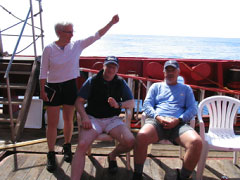|
|
Journals 2005/2006
Susan Holt
Arcadia High School, Phoenix, Arizona
"Investigating Indonesian Tsunami"
M/V Performer
May 9-26 |
 |
 |
Journal Index:
May 8 - 9 - 10 - 11 - 12 - 13 - 14 - 15

16 - 17 - 18 - 19 - 20 - 21 - 22 - 23 |
May 18, 2005
A beautiful morning today with puffy clouds and temperatures reaching the upper 90s ° F. We are presently at a latitude of 3° N and longitude of 93° E. The ROV is ready to go down again and The Performer crew is responsible for getting it in the water. For the seismic equipment, we all are involved in putting it in the water. Kate Moran, Larry Mayer and Jamie Austin are shown here as they discuss fishing. Kate Moran is from the University of Rhode Island, Larry is from the University of New Hampshire and Jamie Austin is from the University of Texas at Austin. As this trip has progressed, I am becoming more impressed with how well known these scientists are in their respective fields and how much they have contributed to science.
(Click on thumbnails below for full version pop-up)

 |  | 
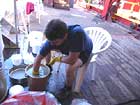 |
| Ed Wardle enjoys a moment of relaxation before filming the deployment of the ROV. The water was absolutely flat all day. We haven't seen any other ships in days. |  | Jon Copley takes the blade samples that have been cut into bricks and stirs them in a bucket with water to suspend the particles. Once the particles are suspended, Jon can then pour that water with the suspended organisms and sediment into the sieves. |
 |
 |  | 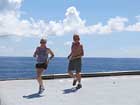 |
| Joelle Galeron sieving the sediments from the blade samples taken yesterday. Notice the stack of sieves (wire at the bottom of metal pans). Each sieve has different size wire to allow different size organisms through to the next pan. She starts with the largest spaces between wires and works her down to until she has collected the smallest organisms by running water over the samples. She then takes the samples left on the wire and rinses them with formaldehyde and puts them into specimen bottles. |  | Although this trip has been much work, there is time for recreation. We have access to an aerobic room (treadmill, stationary bike, rowing machine) and a weight room. On a day as pretty as this and with smooth seas, the helipad makes an excellent place to exercise.
Before the ROV reached the surface, Kate Collins came in to tell me that there was a sea snake swimming in the moon pool. It was about 3 feet long, black with yellow markings on the tail. It swam around for about 20 minutes then swam out of the bottom. It was amazing to see this so far away from land. Everyone's concern was if it got onto the ROV as it was coming up, there would be a problem because these snakes are very poisonous. Otherwise, there was no way for it to get onto the boat out of the moon pool. |
 |
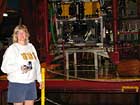 |  | 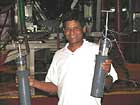 |
| The ROV is brought back up full of exciting specimens. On the video screens, we saw amazing organisms. Although it is hot and humid outside, I am wearing a sweatshirt because the barn where we are working is kept very cold because of all the computers running. Every time I step outside, I have to wait until my camera lens de-fogs, (not to mention my glasses). |  | Baban Ingole with core samples from about 2000 meters below the surface. The ROV operators had to take the claw and pull the corers out of the quiver (the gray sleeves that hold the sample) where the tubes are kept. Notice the water at the top of the tube. The biologists will siphon off that water and look through it for organisms. Below the water is the sediment. |
 |
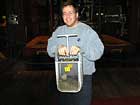 |  |  |
| Everyone got into the action when the samples were pulled out of the ROV basket. Here is Roland Aresenault with a sample collected in the blade. Usually, only sediment samples are collected with the blade, but this time they were able to bring up a sponge. |  | Once the sponge was removed from the blade, it was placed on a flat surface so scientists could take a look at it and measure its length. Many people crowded around to see it because it was so beautiful on camera in the water. Notice to the left, there is a little shrimp sitting on the stalk. This sample is actually four organisms in one catch! When something like this is brought up from such a depth, it will not be alive when it reaches the surface because of the tremendous change in pressure and temperature. |
 |
 |  | 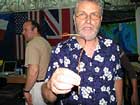 |
| Tim Masterlark (a geologist) really enjoyed rinsing the sample off in salt water so that it could be stored in preservatives. Once preserved, it will be shipped back to a laboratory for someone to classify it. Many organisms from such depths have not been seen before. |  | Biologist Paul Tyler with one of the specimens from the bottom of the ocean. |
 |
 |  |  |
| Paul Tyler and Jon Copley taking layers from the core sample. When the tube is pushed into the sediment, they hope to find microscopic organisms in the sample. They take measured slices so that they can investigate the layers. |  | Baban, Paul, Jon and Tim finished taking samples from the core. The remaining sediment was given to me as a souvenir. |
|
|



